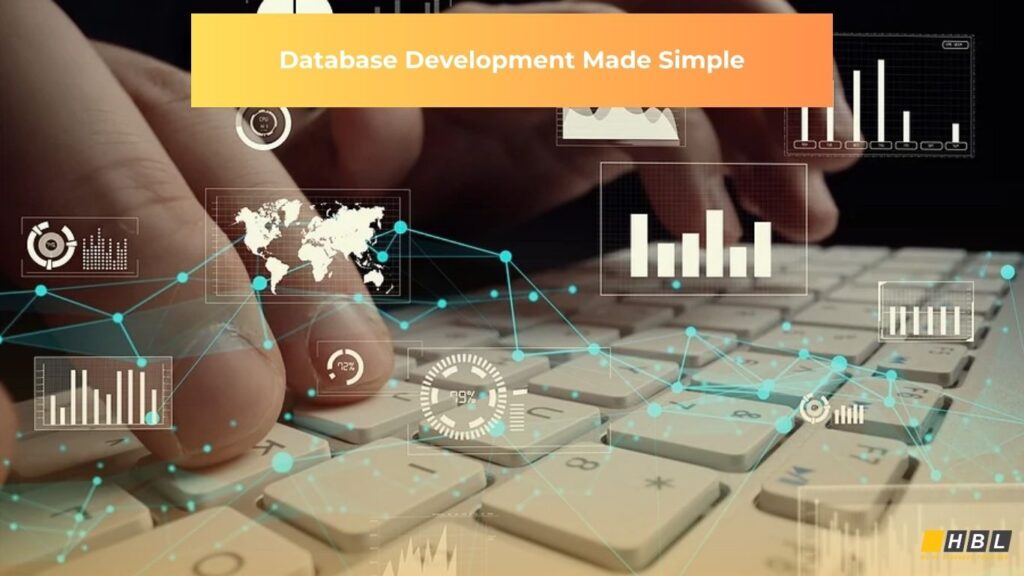Why databases matter
Every modern app—from ride-hailing to online stores—needs a reliable place to keep information. Database development is the craft of planning, building, and taking care of that place so your app can store, find, and protect data quickly and safely.
Think of your database like a well-run library: books (your data) must be labeled, organized, easy to find, and protected from loss. Do this well, and features ship faster, pages load quicker, and outages are rare.

A 60-second history: When did databases begin to be developed?
- 1960s: Early computerized databases appear in large organizations.
- 1970s: The relational model and SQL make databases easier to reason about and standardize.
- 2000s+: Web-scale apps bring NoSQL (flexible, big) and then distributed SQL (scale-out with strong guarantees).
- Today: Cloud databases let teams start small and grow globally without buying hardware.
You don’t need the full timeline to be effective—just know that database tech has matured for decades and you have great options.
What is your first step in developing the database?
Start with requirements.
Before writing a single CREATE TABLE, interview stakeholders and users, capture functional (what the system must do) and data requirements (entities, relationships, cardinalities, volumes, SLAs, retention), and then draft a conceptual ERD. This is consistently listed as the first step in reputable design guides and textbooks. BCcampus Open Publishing+2Redgate Software+2
Deliverables from this step:
- Business glossary and entity definitions
- Use cases & key queries (read/write patterns, latency targets)
- Conceptual ERD and constraints
- Non-functional requirements (security, backup RPO/RTO, data residency)

Database development life cycle (DDLC)
A practical DDLC mirrors SDLC but is tailored to data. Commonly accepted phases:
- Initial study & requirements
-
- Understand current systems and pain points.
- Define scope, entities, sources/targets, performance SLAs, regulatory needs, and success metrics.
- Design (conceptual → logical → physical)
Conceptual ERD → logical keys & normalization → physical tables, indexes, partitions, security model.
- Implementation & loading
- Write DDL, build migrations, seed reference data, set up role-based access control.
- Testing & evaluation
- Unit tests (constraints, functions), integration tests (app + DB), performance testing with production-like data, disaster-recovery drills (backup/restore).
- Operation
- Deploy with versioned migrations. Monitor slow queries, index health, storage, and replication lag.
- Maintenance & evolution
- Continuous tuning, schema refactoring, patching, and lifecycle policies (archival/retention).
Why this matters: treating your database as versioned code (with migrations & CI/CD) eliminates drift, speeds onboarding, and keeps environments reproducible.
6) Database application development: patterns that work
Connect & query layers
- ORMs (e.g., Entity Framework, Hibernate) accelerate CRUD but can hide expensive N+1 patterns—profile queries and use explicit SQL for hot paths.
- Direct SQL / query builders for complex analytics or bulk operations.
- APIs & drivers: prefer battle-tested drivers; enforce connection pooling and sane timeouts.
Migrations & CI/CD
- Store schema as code (Flyway, Liquibase, Prisma Migrate).
- Gate deployments with automated checks: DDL linting, backward-compatibility checks, and smoke tests.
- Blue/green or rolling deploys for zero downtime.
Testing strategy
- Unit: functions, constraints, stored procedures
- Integration: app + DB in ephemeral containers
- Performance: replay prod-like workload; track p95/p99
Resilience patterns
- Backups (daily full + incremental), verified with restore tests
- Replication and failover runbooks
- Idempotent migrations
What is a database application? In short: software designed to interact with a database to store, retrieve, and manage data for users and services—think e-commerce, CRM, or analytics apps.
7) Choosing the right technology (RDBMS, NoSQL, distributed SQL)
Relational (OLTP/OLAP): ACID, strong consistency, mature tooling. Great for transactional workloads and complex joins.
NoSQL (document/column/key-value/graph): flexible schemas, horizontal scale, high write throughput; best for large, semi-structured data or graph traversal.
Distributed SQL (“NewSQL”): relational semantics with scale-out and high availability—useful when you want SQL + ACID + multi-region.
Selection checklist
- Data shape & variability; query complexity
- Consistency vs availability/latency tradeoffs
- Throughput/latency targets; expected growth
- Operational maturity (backups, HA, observability)
- Cloud/platform fit and total cost of ownership

8) Performance, reliability & security checklists
Performance
- Baseline the top 10 queries; create the right indexes (covering, partial, composite); measure improvements.
- Plan partitioning/sharding for time-series or very large tables.
- Use connection pooling, caching (read-through, write-behind), and batch writes.
- Keep statistics fresh; beware implicit conversions and wide scans.
Reliability
- RPO/RTO targets, tested restores, and PITR where available.
- Schema evolution rules: additive changes first (new tables/columns), then deprecations; use views to bridge versions.
- Operational runbooks for failover, hot fixes, and rollbacks.
Security
- Least privilege roles; rotate credentials and manage secrets.
- Encryption in transit & at rest; masked data in lower environments.
- Auditing of DDL/DCL and sensitive DML; data retention & purge jobs.
- Align with applicable privacy regimes (e.g., company policy and local regulations).
Why HBLAB for database development
If you’re looking for a partner to design, build, and operate production-grade databases—HBLAB delivers end-to-end database design & development and database application development services backed by real-world delivery.
What you get with HBLAB
- Deep bench, global presence: 630+ engineers and project managers with strong delivery track records; headquarters in Vietnam and branches across Asia–Pacific (Japan, Singapore, South Korea; presence supporting Australia).
- Senior talent where it counts: ~30% senior-level (5+ years on complex builds).
- Flexible engagement models: BOT, offshore, onsite, and dedicated teams to match budget and speed.
- Cost efficiency: typically ~30% lower than local market rates while maintaining quality.
- Security & quality governance: CMMI Level 3 certified processes; strict security controls and privacy practices. HBLAB GROUP
- Broad tech coverage: SQL (PostgreSQL, MySQL, SQL Server, Oracle), NoSQL (MongoDB, Cassandra), distributed SQL, streaming (Kafka), and data pipelines—plus cloud PaaS expertise on major providers.
- From greenfield to modernization: schema design, performance tuning, migrations, DR and HA set-up, and 24/7 managed operations.

FAQs
Typical outcomes: faster query times, safer releases (schema-as-code), and predictable operations under real-world load.
- Do I need a relational (SQL) or NoSQL database?
Use relational (SQL) when you need strong consistency, transactions, and rich joins. Choose NoSQL for flexible schemas, very high write throughput, or highly connected/large-scale data. Many products use both (polyglot persistence) for different parts of the system.
- What is normalization—and do I need it?
Normalization organizes data to remove duplication and protect integrity (e.g., 3NF). Start normalized for correctness; later denormalize selectively for performance based on measured bottlenecks.
- When is denormalization a good idea?
When reads dominate and joins become a hotspot. Denormalize after profiling, and document the write-path trade-offs (updates may touch multiple places).
- How many indexes is too many?
Indexes speed reads but slow writes. Index the top queries (by frequency and latency) and review monthly. Prefer covering or composite indexes over many single-column ones.
- How does HBLAB ensure security and reliability?
Security by default (least privilege, encryption, audit trails), versioned migrations, tested backups/DR, and documented runbooks, aligned with CMMI Level 3 practices.
Read more:
– Customer Database Platforms: The Comprehensive 2025 Guide to Unified Customer Data Management
– Unlock Business Growth with the Right Data Warehouse Solution – Here’s How

